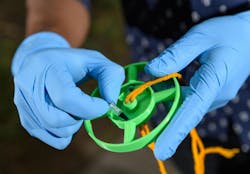The top, a toy still enjoyed by kids around the world, today has inspired an inexpensive, hand-powered centrifuge that could change how field biologists conduct research. It could also enable high school students and others with limited resources carry out their own state-of-the-art experiments.
The device, a portable centrifuge for preparing scientific samples including DNA, was developed by students from Lambert High School in Georgia, with help from advisor M. Saad Bhamla, a professor at the Georgia Institute of Technology.
The 3D-Fuge is based on earlier work by Bhamla and colleagues at Stanford University on a simple centrifuge made of paper, dubbed the “paperfuge.” It was inspired by whirligigs, toys composed of string and a button that Bhamla played with as a child. He later discovered these toys have been around for 5,000 years. They consist of a button-like disk with two holes. Some flexible cord or string is threaded through the holes and tied into a loop. That contraption is then swung with two hands until the button is spinning and whirring very quickly.
Gaurav Byagathvalli, a senior at Lambert High School in Forsyth County, Georgia, demonstrates an inexpensive centrifuge created with a 3D printing process. M. Saad Bhamla, a Georgia Tech professor, observes the device, which can be part of a “lab in a backpack.” (Photo: Rob Felt, Georgia Tech)
The earlier paperfuge uses a disk of paper with small plastic tubes filled with samples to be separately glued to it. Having used it, he and his colleagues say it separates liquids into various components and creates high-quality samples.
Two years ago, Bhamla was approached by the Lambert High students to see if the paperfuge could be adapted to handle larger samples. (The paperfuge is limited to samples of ~1 microliter or less, about drop of blood).
He helped them develop the 3D-printed 3D-Fuge, which includes cavities for tubes capable of holding samples 100 times the size of those of the paperfuge. The team developed two equally effective designs: one for field biology and the other for the high school’s synthetic biology project.
Bhamla notes that the 3D-Fuge has some limitations. For example, it can only process a few samples at a time (some applications require thousands of samples). Further, because it’s 10 times heavier than the paperfuge, it can’t reach the same speeds or produce the same forces of that device. That said, it still weighs only 20 grams, slightly less than an AA battery.
A sample vial is placed into the disk of a 3D-Fuge for separation. (Photo: Rob Felt, Georgia Tech)
The 3D-Fuge has since been tested in two separate applications. In a rainforest in Peru, the 3D-Fuge was part of “lab in a backpack” used to identify four previously-unknown plants and insects by sequencing their DNA. Back in the U.S., a slightly different design let high schoolers take a new approach to creating living bacterial sensors for detecting disease.
Thanks to social media, the device has already generated interest from around the world, including emails from high-school teachers in Zambia and Kenya.
To better share the work, the team has posted the 3D-Fuge designs, videos, and photos online available to anyone.
This project meshed well with of Bhamla’s areas of interest: developing tools for frugal science, which is research just about anyone can afford. The tools behind state-of-the-art science often cost thousands of dollars which makes them inaccessible to those without serious resources.
Centrifuges are a good example. A small benchtop unit costs between $3,000 and $5,000; larger units cost many times that. Yet the devices are necessary to produce concentrated amounts of, say, genomic materials like DNA. By rapidly spinning samples, they separate materials of interest from biological debris. The 3D-Fuge works as well as its more expensive cousins, but costs less than $1.



